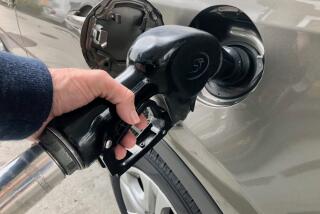U.S. Forecasts Gasoline Price of $1 a Gallon
- Share via
WASHINGTON — The average price of gasoline should climb back above the $1-a-gallon mark this summer, slowing the growth of driving and resulting in a drop in fuel use for the season, the Energy Department predicted today.
The quarterly forecasts of energy markets and supplies by the department’s Energy Information Administration also saw higher crude oil prices and fairly stable domestic crude oil production from now into next spring.
The average pump price of gasoline of all grades, including state and local taxes and lumping together full-service and self-service stations, was 93 cents a gallon for all of 1986, 87 cents during the summer and 90 cents in the first three months of 1987, the department calculated.
This year, the summer average will be $1 and that figure should rise 2 cents a gallon in each of the following quarters, it said.
After accounting for inflation, the real price of gasoline will be 11% higher this summer than last, and this should mean a 1.2% decline in consumption to 7.18 million barrels per day, the forecast said.
Supplies should be adequate because inventories are well above normal, the department said.
2.1% Driving Increase Seen
Driving increased 5% last summer over the 1985 season but this year the increase should be held to about 2.1%, the department said.
“Increases in vehicle efficiency projected for 1987 and 1988 more than compensate for the impact of increased driving activity on motor gasoline consumption,” the report said in predicting lower demand for fuel.
“New-car sales were very strong during 1986; these new cars, with an average on-the-road efficiency of close to 23 miles per gallon, are helping push the fleet average up by 2% in 1987 to 17.3 miles per gallon,” it added.
But the government’s easing of new-car mileage standards last year will reduce future efficiency gains, the department said.
By the end of May, at least 12 states will have installed 65-m.p.h. speed limits on rural interstate highways, an increase of 10 m.p.h. from last year’s nationwide maximum.
Although cars lose 5% to 30% in fuel economy at the higher speed, the department made no explicit forecast of what the increase in gasoline demand will be as a result, other than to guess that it will be “several hundred thousand barrels per day.”
More to Read
Inside the business of entertainment
The Wide Shot brings you news, analysis and insights on everything from streaming wars to production — and what it all means for the future.
You may occasionally receive promotional content from the Los Angeles Times.










